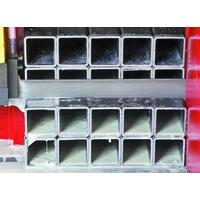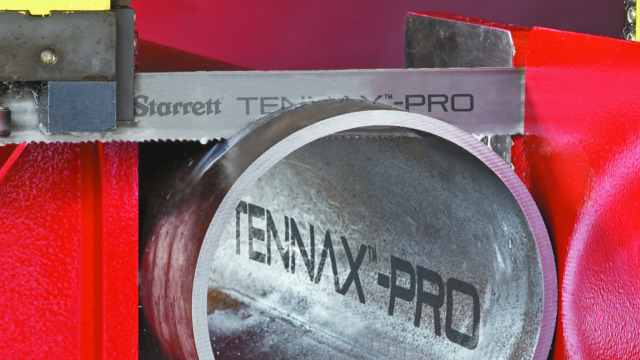STARRETT NEWS & EVENTS
Tube and Pipe Sawing: Varying Applications Demand Different Solutions
Consider the Challenges to Determine the Best Band Saw Blade for the Job
Understanding some typical challenges when sawing tube and pipe will result in more efficient cutting processes. To follow, we examine issues you may encounter when cutting bundles, working with different materials, having scale or straightness issues with tubing, and how pipe wall thickness factors in to the sawing process.

Bundles Bundles present unique challenges when it comes to cutting tubes and other structural shapes. Because speed of cutting bundles is based on the type of material and not the shape, it is necessary to consider a different tooth. For example, if the piece being cut is a simple 4" square pipe with a 1/4" wall, depending on desired results, a 4/6, 5/8 or even 6/10 tooth blade will work. When bundling, based on the size of the bundle, the cross section the blade actually cuts can change. For example, using the 4" square pipe example in a bundle of 4 pieces side-by-side and 4 pieces high, the blade is now cutting across a 16" solid depending on the angle of the head each time it travels through the tops or sides of the tubes. In addition, the 1/4" wall has in effect become a 1/2" wall. Both 6/10 and 5/8 tooth blades are now much too fine to cut the material efficiently. So, moving to a 4/6 or even a 3/4 tooth blade would offer better cutting rates. |  |
While not as much a concern for square tubing, round tubing tends to want to spin when being cut. Therefore, it is necessary to ascertain that the bundles are tightly clamped. Typically, both side clamps and top clamps are needed. In some cases, operators will tack weld the ends to prevent the tubes from spinning, and while this does help, it will not stop the tubes from vibrating when being cut. Vibration of any sort will cause tooth damage and blade life will suffer.
When cutting bundles, the machine setup is important as well. If the machine head is not canted, it will be more difficult to determine the correct blade pitch as the blade "sees" the full amount of material. If the blade has a cant to it, the blade will not see the full 16" solid as in the previous example.
Lastly, cutting coolant is an important consideration. While flood coolant is still the best for blade life, there are many mist systems on the market that warrant consideration. While the advantage of mist coolants is, they do not flow down the material and end up in a puddle at the end of the bars, the disadvantage is they also do not work as well and heat may build up on the blade. If at all possible, flood coolant is recommended.
Materials
As with all sawing applications, knowing your material is paramount to choosing the best saw blade and having optimal cutting performance. In some cases, it is easy to identify the material. The difference between standard A500 tube and Alloy (4130) steel pipe is visually easy to identify.
However, in other instances, the difference is more challenging to visually identify as is the case with A500 and A53. While both have similar properties, there will be differences in how they are cut. Blade speeds are typically determined by the type of material, not the shape. For example, when working with A500 versus 4130, a feed and speed chart will give you a great starting point. Generally speaking, the harder the material, the slower the blade speed. This is also true of the feed rate. Harder material will simply not cut as fast as softer materials, no matter its shape or size. So solid, structural or tubing feeds and speeds are all dependent upon knowing the exact type of material being cut.
Scale or straightness of tubing
Depending upon the tube material and lengths, both scale and straightness can play a role in blade life. Typically, a light coat of rust resulting from being exposed to the elements in an open air yard is not a huge issue, but scale from some manufacturing processes can be detrimental. In some materials, this scale can be harder than the material being cut, and damage the teeth as the cut is initiated. In addition, when cutting 20', 40' or longer pieces, tube straightness will play a role in how straight the cuts are.
While the pieces are usually clamped, often the clamps do not have enough strength to overcome the challenges of crooked pieces. With crooked material between the vises, even though the blade and machine are cutting straight, a crooked cut will result. Unloading the material after the cut and checking it with a square will confirm the inaccuracy. This result is also common when the support tables are unlevel. In effect, the material comes into the machine at an angle which results in cuts that either cut out at the bottom or at the top. This is easily remedied by checking the level and readjusting as necessary.
Thin Wall versus Heavy Wall Pipe Similar to bundles and all materials, the size of the material and wall thickness determine the tooth pitch, as well as the type of blades used for varying applications. In thinner walled applications, blades with a heavier tooth back and more set to the teeth are typically the go-to blade. The heavier tooth back provides more strength and better shock resistance to each tooth. This allows for longer blade life when the teeth are constantly going in and out of the material, traversing across thick and thin sections. In addition, these blades usually have a wider tooth set with a larger kerf. This minimizes stresses in the material that tends to pinch the blades. In most cases, a wider set blade can eliminate pinching altogether. |  |
Reminder - feed rates are determined by the "type" of material and are measured in square inches per minute. It then follows that much heavier walled pipe would cut slower from a linear perspective, as the blade is clearing a larger percentage of material than in a thin walled pipe. In many cases, depending on the definition of thick wall pipe, a blade designed for solid materials can perform better than one designed for thin wall and structural materials. Less set means less kerf which results in less material being removed per cut. The outcome is faster sawing and more precise control over feed pressure and feed rate.
Matters of Efficiency
Equally important for maximizing tube and pipe sawing operations are following some basic saw machine and band saw blade setup guidelines, and good maintenance practices.
- Coolant is critical for both cooling and lubricating. If it is mixed incorrectly or the wrong type of coolant (i.e. neither cooling or lubricating) is present, it can lead to excessive heat and chip welding. Adjusting for proper coolant flow and ratio is key because cutting fluid is necessary on almost all materials. It provides both cooling and lubrication to the cutting surface. Without it, excessive heat is generated, leading to poor blade life and possible tooth strippage.
- Pay attention to the chip brush. If it is worn, mis-adjusted or missing chip brush, then replacing or adjusting the chip brush is recommended. While a chip brush is not technically responsible for chip welding, if a brush is not installed correctly or is inoperative, it can allow chips to load up in the gullets which can increase heat and lead to chip welding.
- If you notice that the band saw blade teeth are dull or damaged, install a new blade. Once teeth are damaged, their clearances and angles will be different, causing what will range from a mild washboard to a significant washboard cut.
- Loading bundles can be a laborious process. When it is necessary to load the material one piece at a time, a decision will have to be made whether it is worth the time and effort to make a bundle. If there are many cuts to be made, in most cases it will be worth doing. However, if each piece is only being cut a couple of times, from a labor standpoint it may be best to cut each piece singularly. The decision to bundle cut is based on the number of pieces needing cut compared with the time to create a bundle. Sometimes material arrives on a truck already bundled, and assuming all the pieces need to be cut and the machine can handle the bundle size, it makes sense to simply load the full bundle and start cutting.
- As with any machinery, saw maintenance is important. Before making any cuts, guides should be checked for wear or cracks, blade tension and blade tracking should be adjusted properly. In general, the saw must be in good working order.
Since bundles of tube/pipe are larger than any single piece, machine issues will be compounded. For example, if the guides are not adjusted correctly and you are cutting through a 4" piece of square tubing, approx. .030 runout may occur. While this may be acceptable for 1 piece, there is a very good chance that when stacking 4 pieces high, the runout will be in excess of 4 times higher when measured on the whole of the bundle. This will result in cuts that are no longer in tolerance. While it depends on your expectations, bundles will compound any small issues into issues that create scrap pieces.
.jpg?sfvrsn=76469ccc_10)
